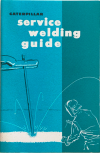milon
Member
Hello all,
We are a quartzite rock quarry located in the Utah/Nevada desert. It is small family owned operation that sometimes can afford a decent welder and sometimes cannot. When we cannot, my dad and I fill in the best we can do.
For most projects, we do ok and have lasting results. For some heavy equipment repair, we have failed to have good results. Rewelding heavy ripper teeth and trackhoe buckets have sometimes failed. Our application is much harder on equipment than normal excavating/ripping, and any weakness is quickly exposed.
Most of the failures have not been the welds themselves, but rather in the orignial material next to them. Dad says that he thinks this could be due to crystallization of the original material durring the welding process. I have heard that preheating the material before welding can help. Is this recommended? If so, how would we go about heating such large pieces of metal? What temps are required, and how do I know when we get there?
We use stick or a Lincoln LN-25 Wire-Feed with Lincoln 400Amp Desiel Welder for on-site repair, but most projects can be brought down to the shop where we use a Lincoln MIG 225. We have carbon gougers that I have used to clean out cracks on implements and machinary before rewelding them. I am decent at running a bead, but lack real knowledge about heavy equipment welding.
Any help would be apriciatied. I will try to answer any questions that you may have in trying to understand either our problems or process...etc.
Also, is there a welding instructional manual that you would recomend getting that would cover Heavy Equipment repair?
We are a quartzite rock quarry located in the Utah/Nevada desert. It is small family owned operation that sometimes can afford a decent welder and sometimes cannot. When we cannot, my dad and I fill in the best we can do.
For most projects, we do ok and have lasting results. For some heavy equipment repair, we have failed to have good results. Rewelding heavy ripper teeth and trackhoe buckets have sometimes failed. Our application is much harder on equipment than normal excavating/ripping, and any weakness is quickly exposed.
Most of the failures have not been the welds themselves, but rather in the orignial material next to them. Dad says that he thinks this could be due to crystallization of the original material durring the welding process. I have heard that preheating the material before welding can help. Is this recommended? If so, how would we go about heating such large pieces of metal? What temps are required, and how do I know when we get there?
We use stick or a Lincoln LN-25 Wire-Feed with Lincoln 400Amp Desiel Welder for on-site repair, but most projects can be brought down to the shop where we use a Lincoln MIG 225. We have carbon gougers that I have used to clean out cracks on implements and machinary before rewelding them. I am decent at running a bead, but lack real knowledge about heavy equipment welding.
Any help would be apriciatied. I will try to answer any questions that you may have in trying to understand either our problems or process...etc.
Also, is there a welding instructional manual that you would recomend getting that would cover Heavy Equipment repair?

